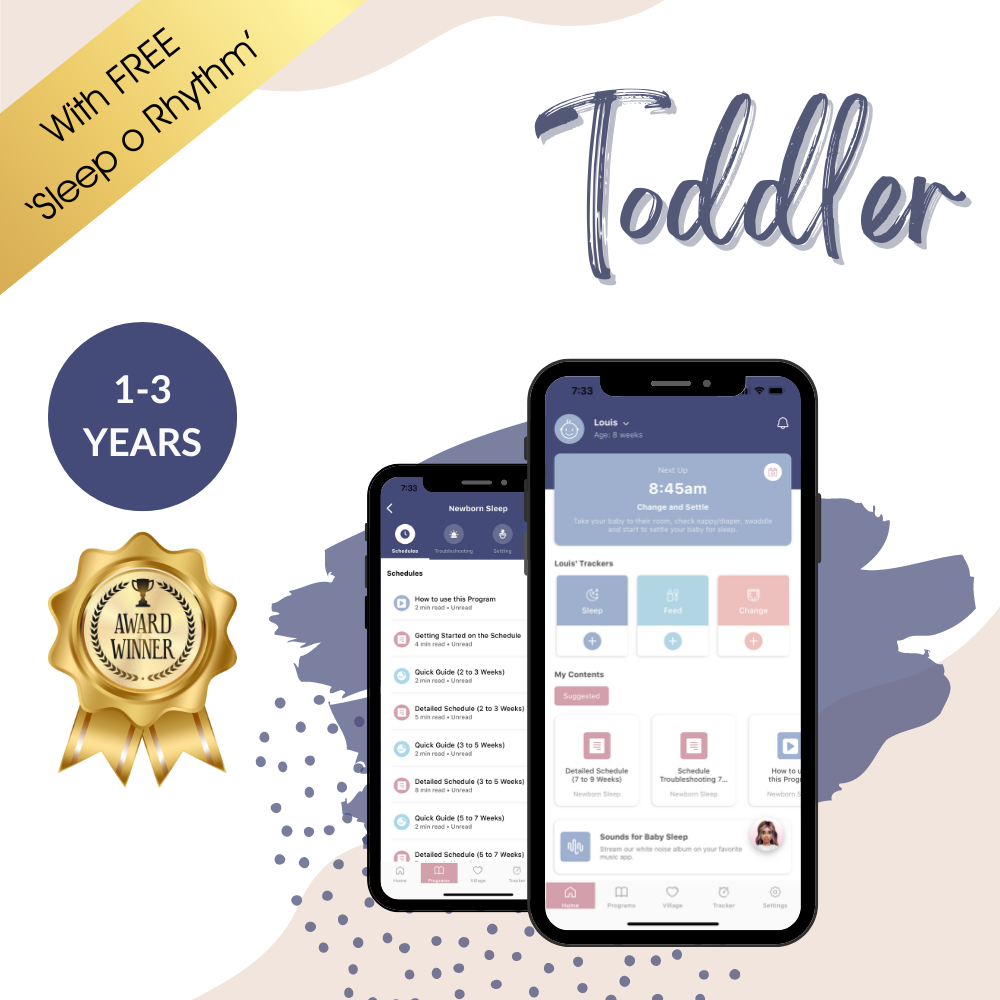
1 Month Old Sleep Schedule: Routines, Wake Windows & Tips


As a new parent, one of the most common concerns is understanding and managing your baby's sleep. At just one month old, your little one is still adjusting to life outside the womb, and sleep plays a crucial role in their growth and development. Here’s what you need to know about your 1-month-old’s sleep needs.
Summary
At 1 month, babies sleep about 17 hours in 24 hours, spread across short naps (up to 2.5 hours) and overnight stretches of 3–4 hours, with wake windows around 1.5 hours to prevent overtiredness. Their circadian rhythm is still developing, so help distinguish day and night with bright awake periods, a very dark sleep space, quiet night feeds, and capped daytime naps. Watch both the clock and cues (yawning, fussiness, eye rubbing, zoning out), support sleep with safe, dark, swaddled environments plus white noise, and expect feeds every 2–3 hours. Over the next few months, sleep will gradually consolidate, with longer night stretches and more predictable daytime naps by around 3–4 months.
In this article:
- Newborn sleep schedule
- Understanding your newborn's sleep patterns
- Signs your baby needs sleep
- Creating a sleep-friendly environment
- Feeding and sleep
- What to expect moving forward
- Final thoughts
Newborn Sleep Schedule
At one month old, babies typically need about 17 hours of sleep within a 24-hour period. Your baby’s sleep will be spread out over several naps, up to 2.5 hours long, followed by some potentially longer periods of sleep overnight, this could be 3-4 hour stretches. These sleep patterns can seem fragmented and short, but are entirely normal and can reflect your baby's need to feed frequently, especially overnight. Your baby can only stay awake for around 1.5 hours at a time - this is known as their "wake window". If they're awake longer than this they will get quickly overtired and be more difficult to settle to sleep.
Your newborn's sleep schedule might look like:
- Morning wake up (aim for 7am to start their day)
- 1.5 hour wake window, which includes feed, change and winding
- First nap, around 1.5 hours long
- 1.5 hour wake window, which includes feed, change and winding
- Second nap, 2.5 hours
- 1.5 hour wake window, which includes feed, change and winding
- Third nap, 1.5 hours long
- 2 hour wake window, which includes feed, change and winding
- Bedtime, 7pm
Understanding Your Newborn's Sleep Patterns
Newborns, including 1-month-olds, do not have a fully developed circadian rhythm, the internal body clock that helps us distinguish between day and night. As a result, their sleep patterns can start to become irregular and unpredictable. Over the next few months, as your baby’s circadian rhythm begins to develop, you may notice more defined sleep-wake cycles. You can also assist your little one's circadian rhythm by taking steps to differentiate day and night for them. This would look like:
- not letting them nap for more than 2.5 hours at a time during the day
- having their awake periods in natural light
- using a very dark room for naps and night sleep (no nightlights!)
- keeping night wakes/feeds quiet, dark and "sleepy"
During the first month, it’s also common for your baby to have a mix of deep sleep and lighter sleep stages. You may observe that your baby is more likely to wake easily during light sleep stages. This can lead to frequent awakenings throughout the day and night if something is bothering your baby, such as wind, hunger, being too hot or cold, or being unswaddled.
Need support figuring out your newborn's sleep?
Being a new parent can be overwhelming. You probably have lots of questions. Find the answers to all your questions and more in our Sleep Programs to future-proof your newborn's sleep.
Get our Sleep Programs
Signs Your Baby Needs Sleep
At this age, it can sometimes be challenging to recognize when your 1-month-old is tired, especially since their cues can be subtle. It is a good idea to work off both your baby's cues and also off the clock to know when to put your baby down for a nap. At one month old, babies should only be awake for 1 hour 30 to 1 hour 40 between naps. If they're awake longer than this they will quickly become overtired and very difficult to settle. On the flip side, if you are still aiming for very newborn sleep patterns with your baby and are trying to put them to sleep much earlier than this, they might be resisting settling or only napping for short periods because they simply weren't perfectly ready for sleep yet. (Yes, that's totally a thing!)
In addition to keeping an eye on how long your baby has been awake for, look out for signs such as:
- Yawning: A classic sign of sleepiness.
- Fussiness or irritability: Babies may become cranky when they are overtired.
- Rubbing eyes or face: Another common indicator of fatigue.
- Staring into space or losing interest: If your baby suddenly seems disinterested in their surroundings, it may be time for a nap.
Creating a Sleep-Friendly Environment
While your baby’s sleep patterns are still developing, there are steps you can take to create a soothing environment that encourages restful sleep, both during the day and at night:
- Establish a calm bedtime routine: Even at this early age, a simple routine can signal to your baby that it’s time to sleep. This could include dimming the lights, playing soft music, or giving them a gentle massage.
- Keep the sleep space safe and comfortable: Ensure your baby’s crib is free of any loose bedding, pillows, or toys that could pose a safety risk. The room your baby sleeps in should be kept as dark as possible, at a comfortable temperature, and white noise should be used to both soothe your baby and to mask household sounds.
- Encourage day and night differentiation: During the day, keep the room bright and engage with your baby during wakeful periods. At night, keep lights low and interactions quiet to help your baby begin to recognize the difference between day and night.
- Swaddle your baby for all sleeps: This is the oldest sleep trick in the book (for good reason). Swaddling helps your little one to feel snug and secure, activating their parasympathetic nervous system and initiating a calming reflex. Swaddled babies sleep better.
Feeding and Sleep
At one month old, babies need to feed frequently, often every 2 to 3 hours. This need for regular feeding means that your baby will likely wake several times during the night. While this can be tiring for parents, it’s important to remember that these frequent feedings are essential for your baby’s growth and development.
Over time, as your baby grows and their stomach capacity increases, they will start to go longer between feedings, which can help them sleep for longer stretches at night.
If your little one is waking more at night for milk, then sleeping longer stretches during the day and waking less, it could be that they have their days and nights mixed up. Try waking them from their naps in the day so that they're sleeping no longer than 2 hours at a time, and encourage big feeds during their awake periods. This should help their circadian rhythm start to differentiate night from day and you should see some longer stretches of sleep overnight.
Feeling confused about your baby's sleep needs?
Let our sleep experts help you every step of the way. Together we can solve your little one's sleep challenges
Get our Sleep Programs
What to Expect Moving Forward
As your baby continues to grow, their sleep needs and patterns will evolve. By around 3 to 4 months, you can start to notice longer stretches of sleep at night and more predictable nap patterns during the day. But don't get comfortable! Baby sleep is constantly changing and it is important to keep on top of that development so you know how to best support your baby to sleep well.
Final Thoughts
Understanding your 1-month-old baby’s sleep needs can help you provide the care and support they need during these early weeks. While the frequent wake-ups and irregular sleep patterns can be challenging, it’s a temporary phase that will eventually give way to more regular sleep cycles - and you can always take a more active approach to helping your little one start to regulate their sleep patterns. The goal at this age is to focus on gently setting up great sleep habits, creating a comforting sleep environment and getting to know your baby’s cues, knowing that each step and each day brings you closer to a more settled routine.
------------------------
Bibliography
Coons, S., & Guilleminault, C. Development of sleep-wake patterns and non-rapid eye movement sleep stages during the first six months of life in normal infants. Pediatrics, 69(6), 793–798 (1982).
https://europepmc.org/article/MED/7079046
Coons, S., & Guilleminault, C. Development of consolidated sleep and wakeful periods in relation to the day/night cycle in infancy. Developmental Medicine & Child Neurology, 26(2), 169–176 (1984).
https://onlinelibrary.wiley.com/doi/10.1111/j.1469-8749.1984.tb04428.x
Peirano, P., Algarín, C., & Uauy, R. Sleep-wake states and their regulatory mechanisms throughout early human development. Journal of Pediatrics (2003).
https://www.jpeds.com/article/S0022-3476(03)00404-9/fulltext
SleepHealth.org. Healthy infant sleep: core dimensions and developmental guidance.
https://www.sleephealth.org/infants/
Sleep Foundation. Newborn sleep schedule: what to expect.
https://www.sleepfoundation.org/baby-sleep/newborn-sleep-schedule
Frontiers in Neuroscience. Maturation of infant sleep in the first six months: variability and trajectories (2025).
https://www.frontiersin.org/articles/10.3389/fnins.2025.1581325/full
BMC Pediatrics. Early structured sleep interventions improve overnight sleep by 4 months: a randomized controlled trial (2024).
https://bmcpediatr.biomedcentral.com/articles/10.1186/s12887-024-04771-6
The Guardian. Put your baby down to nap near a washing machine, expert says – Professor Helen Ball (2025).
https://www.theguardian.com/lifeandstyle/2025/apr/13/put-your-baby-down-to-nap-near-a-washing-machine-expert-says
The Times. Help! When will my baby sleep through the night? (2025).
https://www.thetimes.co.uk/article/help-when-will-my-baby-sleep-through-the-night-kvhw5gw0n
Parents.com. A parent’s guide to safe sleep practices for your baby (2025).
https://www.parents.com/a-parents-guide-to-safe-sleep-practices-for-your-baby-11729942

Receive product and services updates, promotional offers and other marketing communications based.





